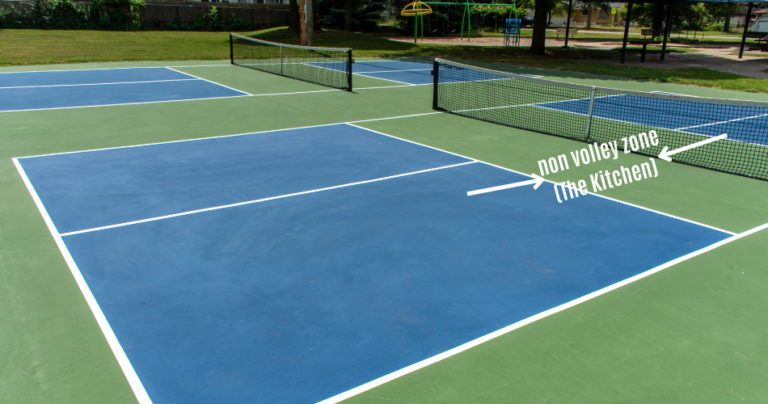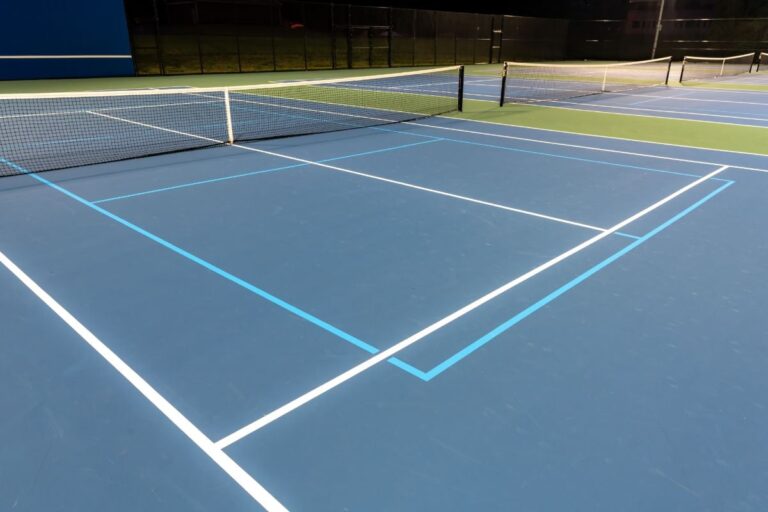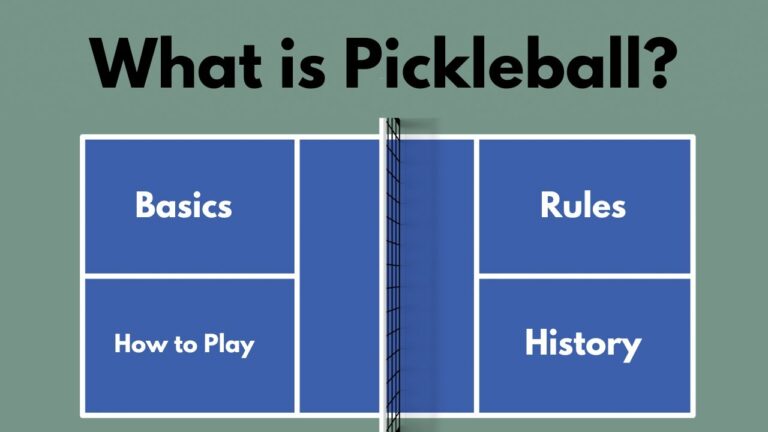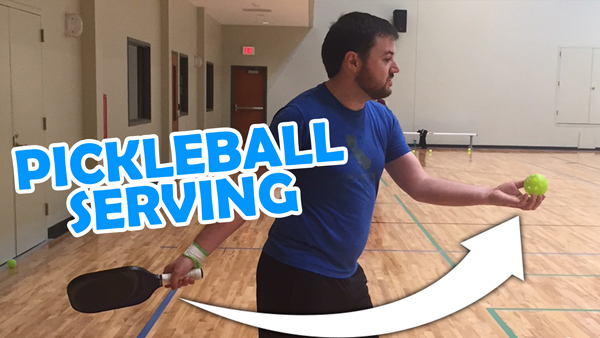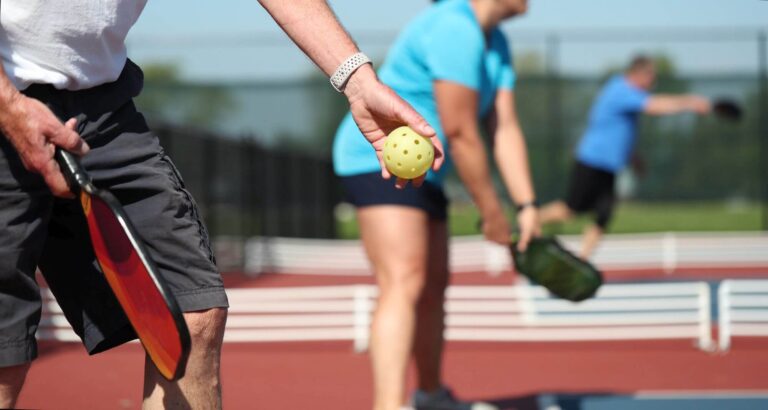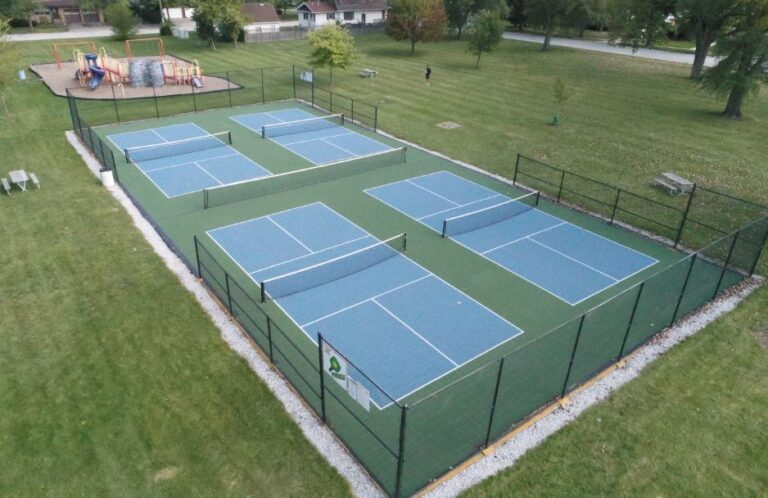Mastering Pickleball Rules Singles : A Player’s Guide
In Pickleball Rules Singles, you face a 1-on-1 match where strong agility, precision, and strategy are key. You serve based on your score, with faults caused by incorrect serve sides or stray shots. Fair play is maintained through the double bounce rule, requiring a bounce on each side before volleying. Volley near the net to keep your opponent defensive, and make accurate line calls to respect the game’s integrity. Mastering techniques, serve tactics, and defensive maneuvers will boost your gameplay. While these insights get you started, a deeper understanding will provide added strategies and techniques to enhance your gameplay.
Main Points
- Singles pickleball is a 1-on-1 match where server rules and scoring are crucial.
- Only one serve per player is allowed, with side-switching after winning a point.
- Servers must serve from the correct court based on the score.
- Faults, non-volley zone rules, and accurate line calls can affect the game’s outcome.
- The double bounce rule requires the ball to bounce once on each side before volleys are permitted.
Understanding Singles Pickleball
To truly grasp singles pickleball, you need to know that it’s a 1-on-1 match where player positioning and serving side shift after each point. This shift isn’t essential. It’s a fundamental part of scoring in singles pickleball.
You see, scoring is based on the serving player’s side. When you serve, you’ve got the chance to earn a point. But, you can’t afford to get complacent. If you mess up, it’s called a fault, and you’ll lose your rally.
Faults can come from a few different scenarios. Maybe you served from the wrong side, or perhaps you hit the ball out of bounds. In any case, faults can quickly turn the game against you. So, it’s important to follow the rules to a tee.
Singles pickleball also demands a different strategy compared to doubles play. You’re on your own out there, and every move you make counts. It’s a game that challenges your agility, precision, and tactical thinking. So, next time you step onto the court, remember: serve wisely, avoid faults, and keep your eye on the score.
Key Equipment for Singles

Equipping yourself with the right gear is a game-changer in singles pickleball, enhancing your control, performance, and overall experience on the court. The key equipment you need for singles pickleball includes a quality paddle, proper footwear, comfortable athletic clothing, sunglasses, and a hydration pack.
A quality paddle is essential for controlling your shots and improving performance. It allows you to make precise shots and give your best in the game. It’s not about the price tag but rather the quality and how well it suits your playing style.
Proper footwear with good traction is also important. It lets you move swiftly and prevents slips, offering you an advantage in singles pickleball. Comfortable athletic clothing that allows for easy movement is another aspect you can’t overlook. It enables you to move freely and focus on the game rather than adjusting your outfit.
Sunglasses with UV protection can help reduce glare on sunny days, giving you a clear view of the court and the pickleball. Lastly, a water bottle or hydration pack is essential to keep you hydrated and performing at peak levels. It’s a simple yet crucial part of your singles pickleball gear.
Server Rules and Scoring
Now that you’re geared up, let’s comprehend the rules for serving and scoring in singles pickleball. Understanding how to serve in the game is essential. There’s only one serve per player. You need to make sure you’re serving from the correct court when your score is even and from the left when it’s odd.
The server must switch sides after winning a point, keeping the game dynamic and challenging. Remember, faults, non-volley zone rules, and line calls still apply and can greatly impact your serve.
Scoring is equally important. In singles pickleball, the server’s score is always mentioned first, followed by the receiver’s. There’s no concept server #1 or server #2, simplifying the scoring system a bit.
Here’s a quick summary:
| Rule | Description | Applies to |
|---|---|---|
| Serving | One serve per player, side-switching after a point. | Server |
| Scoring | Server’s score first, then receiver’s. | Server and Receiver |
| Faults and Line Calls | They apply as usual. | Server and Receiver |
Master these rules, and you’re one step closer to acing your pickleball game.
Volleys and Double Bounce Explained
You’ve got to know your volleys and the double bounce rule in singles pickleball.
The volley, an essential shot taken near the net, can keep your opponent on the defense.
However, you can’t forget the double bounce rule which requires the ball to bounce once on each side before volleys are allowed.
Understanding Volley Rules
In singles pickleball, it’s vital to get a solid grasp on volley rules, including the nuances within the Non-Volley Zone and the double bounce rule.
Volleys are allowed, which means you can hit the ball out of the air before it bounces. However, the Non-Volley Zone, or the ‘kitchen,’ restricts you from volleying inside this area. It’s a no-fly zone for volleys, so to speak.
Then, there’s the double bounce rule. It requires the ball to bounce once on each side before you can make volleys. This rule means you’ll need to let the ball bounce before getting aggressive.
Understanding these rules and mastering volley techniques can give you a significant advantage in your pickleball singles matches.
Double Bounce Breakdown
To get a strong hold on singles pickleball, it’s essential to dissect the Double Bounce Rule, which mandates the ball to bounce once on each side before you’re allowed to volley. This rule guarantees fair play and prolongs the rallies, adding an exciting layer of strategy to the game.
After the serve and return in singles pickleball, you must let the ball bounce again before hitting volleys. So, it’s not just about hitting the ball, it’s about timing and patience. Mastering this rule is a crucial part of your gameplay strategy.
Ultimately, the Double Bounce Rule enhances the overall experience of singles pickleball, combining skill and strategy in every match. It’s a key component of the game, ensuring the spirit of fair play is upheld at all times.
Making Accurate Line Calls
Ensuring fair play and good sportsmanship requires making every line call with clarity and immediacy in singles pickleball. Line calls are pivotal in maintaining the flow of the game, and your responsibility is to make them as accurate as possible. It’s not just about winning; it’s about displaying integrity and commitment to the game.
Good communication is the key to avoid disputes during the match. If you’re in doubt about a call, always give the benefit of the doubt to your opponent. This shows respect for the other player and solidifies a commitment to fairness that supports the spirit of pickleball.
Deliberately making incorrect line calls will only lead to conflicts and disrupt the game’s rhythm. It’s important to remember that honesty in line calls contributes to a positive playing experience for everyone involved.
In singles pickleball, accurate line calls aren’t solely about rules; they’re about sportsmanship and respect for the game and your opponent. By making clear and immediate line calls, you’ll not only ensure the fairness of the game, but you’ll also enhance the enjoyment of the sport for yourself and others.
Strategies for Winning Singles
As you hone your pickleball skills, it’s essential to focus on mastering basic techniques, effective serving strategies, and defensive maneuvers.
This isn’t just about hitting the ball; it’s about outwitting your opponent and controlling the court.
Mastering Basic Pickleball Techniques
Mastering basic techniques in singles pickleball, such as big serves, returns, shot placement, and angles can greatly enhance your chances for victory. It’s not just about hitting the ball; it’s about where and how you hit it. Your singles game can be greatly improved with strategic player positioning and adept shot placement.
Here are some techniques to keep in mind:
- Ideal player positioning: Staying in the Non-Volley Zone gives you control over the court.
- Utilize passing shots: Aim your returns so they pass by your opponent, forcing them out of their position.
- Play the angles: Use angled shots to make it difficult for your opponent to return.
- Efficient movement: Swift, calculated moves can give you an upper hand.
Implementing Effective Serving Strategies
In singles pickleball, implementing effective serving strategies can dramatically boost your chances for winning matches. It’s important to know that your serve must be accurate as well as varied. Mixing up deep serves, short serves, and slice serves can keep your opponent guessing. Using a strategic serve to exploit your opponent’s weak spots, such as their backhand, can also give you an advantage.
Here’s a quick table to illustrate:
| Serve Type | Advantage |
|---|---|
| Deep Return | Forces the opponent to the back of their court. |
| Short Serve | Draws the opponent closer to the net. |
| Slice Serve | Adds spin, making the ball less predictable. |
Defensive Maneuvers in Singles
To outmaneuver your opponent in a singles pickleball match, you’ll need to position yourself smartly to cover the court efficiently. This is one of the vital defensive maneuvers. Anticipating your opponent’s shots and swiftly moving to counter them can make a big difference.
Here are some tactics to enhance your defensive game:
- Utilize lobs and deep shots to keep your opponent moving
- Stay balanced and be ready to react with effective footwork
- Focus on consistency and placement to force errors from your opponent
- Use defensive volleys to counter aggressive shots
Skinny Singles Vs Regular Singles
When comparing skinny singles to regular singles in pickleball, you’ll find that skinny singles reduces the court size by half, providing a unique, compact version in comparison to the traditional game. This modification in court size allows for a distinctive playing experience, contrasting the standard rules followed in regular singles.
Skinny singles is an excellent option if you’re looking to focus on honing specific skills within a smaller court setting. It’s not just for casual play, either – it’s a fantastic tool for skill development and training purposes. You’re able to narrow down your focus and polish specific techniques, thanks to the reduced court size.
However, don’t expect to see skinny singles commonly in tournaments. While it offers a fun, challenging variation to the traditional play, regular singles still reigns supreme in competitive settings. But, that doesn’t mean you can’t enjoy the unique twist that skinny singles brings to the table. Whether you’re a seasoned player or a newbie, trying out skinny singles could add an extra layer of challenge and excitement to your pickleball experience.
Frequently Asked Questions
What Are Singles Pickleball Rules?
You’re asking about singles pickleball rules. Each player gets one serve per point, scoring has only two numbers. Positioning matters, with the first serve starting on the right. Usual serving, Non-Volley Zone rules, and faults apply.
What Is the Golden Rule Pickleball?
In pickleball, the Golden Rule dictates you must serve from the correct side based on the score. It’s essential because violating it causes faults, leading to lost rallies and potential points. Understand it for successful gameplay.
What Is Skinny Pickleball?
You’re asking about Skinny Pickleball. It’s a variation where you play on half the court size. This format’s great for casual play or improving specific skills, although it’s not commonly used in tournaments.
What Are the Basic Pickleball Rules?
You’ve got to serve diagonally, keep within the court lines, and avoid the non-volley zone. Remember, you can only score points when you’re serving. It’s also essential to understand the double-bounce rule.
Conclusion
So, there you have it! Now you’re armed with the fundamental rules and strategies for singles pickleball. From understanding the server rules to making accurate line calls, you’re set to take on the court.
Remember, practice makes perfect. Whether you’re playing skinny singles or regular singles, armed with these tips, you’re ready to ace your game.
So, grab your paddle, step into the court, and enjoy the thrilling game pickleball. Good luck out there!

